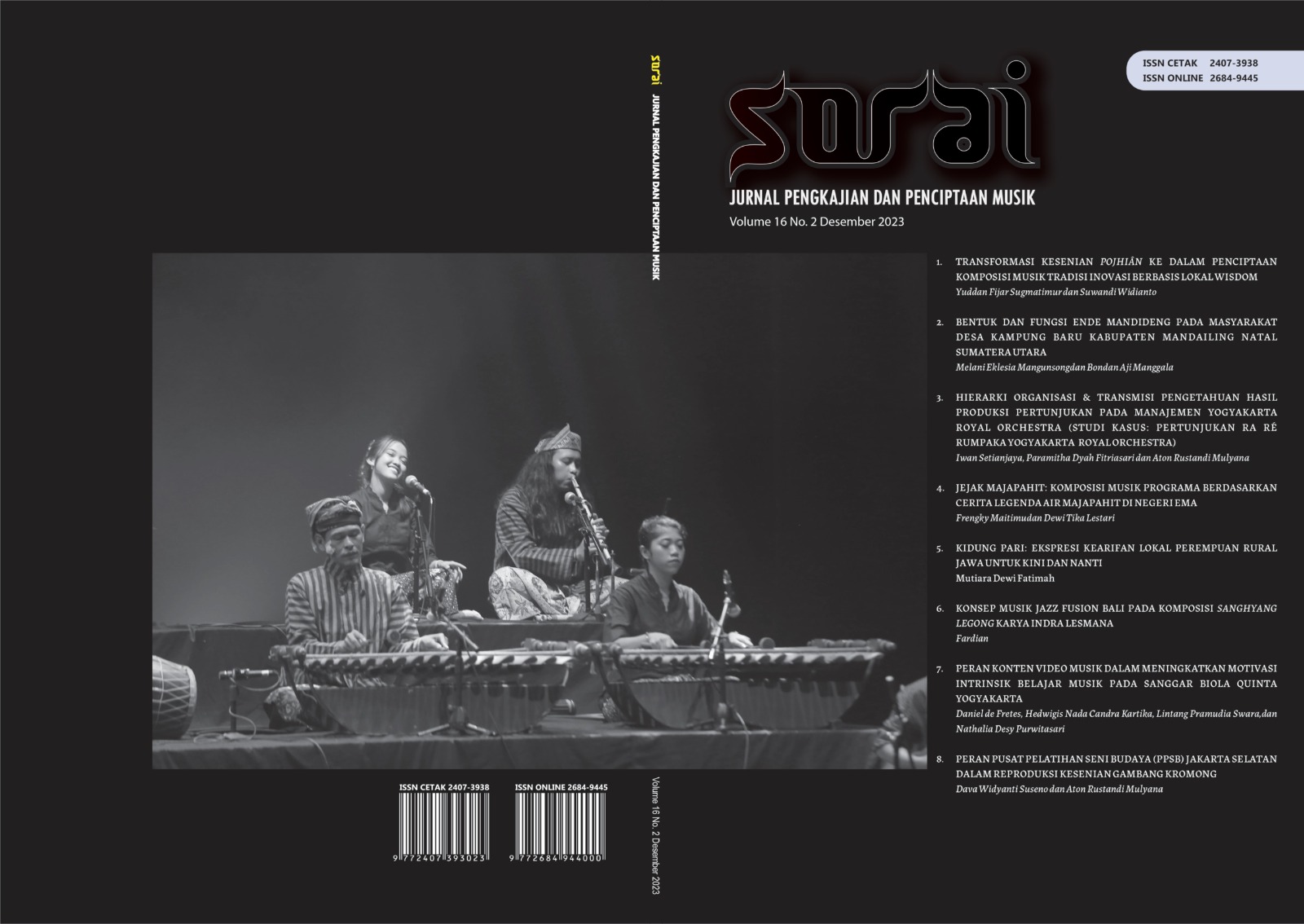KONSEP MUSIK JAZZ FUSION BALI PADA KOMPOSISI SANGHYANG LEGONG KARYA INDRA LESMANA
Main Article Content
Abstract
Jazz Fusion music is one of the music styles currently developing in Bali. The characteristics of Jazz Fusion include combining two musical concept approaches, between local music concepts (Balinese tradisi) and foreign music (western), which results in a different Jazz musical identity. One musical work, Sanghyang Legong, describes the situation of Balinese Jazz Fusion music. Sanghyang Legong musical work results from a collaboration between famous Indonesian jazz musician Indra Lesmana and Balinese gamelan musicians I Made Subandi (alm.) and I Wayan Sudiarsa. This work uses Gending Sanghyang as a source of inspiration developed through a jazz music aesthetic approach. This composition received great appreciation from the music community inside and outside Bali. After being mass-produced in 2017, Sanghyang Legong attracted over 36,000 monthly views on YouTube, Spotify, and Apple Music. This article aims to educate the reader on the composer’s creative process, the resultant musical form, and the work’s significance. The formulation of the problem includes (1) the process of creation, (2) musical form, and (3) implications of Sanghyang Legong composition. The research method uses a qualitative design with a descriptive approach to musicology. Data collection through documentation and interviews. Analysis through the stages of data reduction, data presentation, and conclusion. The elaboration of instruments and playing techniques of Gamelan Singapraga, Suling (Balinese Flute), and Balinese Gending Vocal Style showed the concept of Jazz Fusion music in the composition of Sanghyang Legong. The song has five parts: Solo, Intro, Verse, Chorus, and Interlude. This work has an impactful implication for the sustainability of tourism and Bali’s creative economy.
Downloads
Article Details

This work is licensed under a Creative Commons Attribution-ShareAlike 4.0 International License.
Copyright
Authors who publish to Sorai: Jurnal Pengkajian dan Penciptaan Musik agrees to the following terms:
- Authors retain copyright and grant the journal right of first publication with the work simultaneously licensed under a Creative Commons Attribution License (CC BY-SA 4.0) that allows others to share the work with an acknowledgment of the work's authorship and initial publication in this journal.
- Authors can enter into separate, additional contractual arrangements for the non-exclusive distribution of the journal's published version of the work (e.g., post it to an institutional repository or edit it in a book), with an acknowledgment of its initial publication in this journal.
- Authors are permitted and encouraged to post their work online (e.g., in institutional repositories or on their website) before and during the submission process, as it can lead to productive exchanges, as well as earlier and greater citation of published work.
References
Bandem, I. (1986). Prakempa : sebuah lontar gambelan Bali. Akademi Seni Tari Indonesia.
Beard, D., & Gloag, K. (2016). Musicology: The Key Concepts (2nd ed.). Routledge. https://doi.org/10.4324/9781315647463
Cugny, L. (2019). Analysis of Jazz. In Analysis of Jazz. University Press of Mississippi. https://doi.org/10.2307/J.CTVGS08NJ
Erawati, N. M. P. (2021). Transmisi Legong Dalam Paradigma Sekularisasi Di Bali. Widyadari, 22(1), 263–275.
Gunawan, A. (2014). Proses Kreatif Antonius Wahyudi Sutrisno Sebagai Komposer Gamelan. Jurnal Pengetahuan, Pemikiran, Dan Pengkajian Tentang Bunyi, 14(1), 1–13.
Hamilton, A. (2007). Aesthetics and Music (Continuum Aesthetics). Continuum International Publishing Group.
Hardjana, S. (2018). Estetika musik : sebuah pengantar. Art Music Today.
Kania, A. (2020). Philosophy of western music: A contemporary introduction. In Philosophy of Western Music: A Contemporary Introduction. Taylor and Francis. https://doi.org/10.4324/9781315210629
Kartika, Dharsono Sony. (2004). Pengantar estetika. Bandung: Rekayasa Sains.
Lodra, N. (2017). Tari Sanghyang: Media Komunikasi Spiritual Manusia Dengan Roh. Jurnal Multikultural Dan Multireligius, 16(2), 241–253.
Mack, D. (2004). Sejarah Musik Jilid 4. In Pustaka Musik Liturgi. Pustaka Musik Liturgi.
Mahardika, K. W. A., Santosa, H., & Ardini, N. W. (2020). Transformasi Lagu “Kacang Dari” ke Dalam Chamber Music. Gondang: Jurnal Seni Dan Budaya, 4(2), 96–108. https://doi.org/10.24114/gondang.v4i2.18258
Miller, H. M. (2017). Apresiasi Musik (T. Bramantyo & Sunarto, Eds.). Thafa Media.
Moleong, L. J., & Surjaman, Tjun. (2009). Metodologi penelitian kualitatif. Penerbit PT Remaja Rosdakarya.
Nettl, B. (1964). Theory and method in ethnomusicology. Free Press of Glencoe; Collier-Macmillan.
Putra, I. M. D. (2021). Composition of Pacepuk Sanghyang Karya Musik Pacepuk Sanghyang I Made Dwi Andika Putra. GHURNITA: Jurnal Seni Musik Nusantara, 01(03), 152–160. https://doi.org/10.25124/ghurnita.v1i1.307
Stein, L. (1962). Structure and style; the study and analysis of musical forms. Summy-Birchard Co.
Sudira, M. B. O. (2010). Ilmu seni teori dan praktik. Inti Prima.
Sudirana, I. W. (2019). Bali Fusion Pop Music. JOMSTI: Journal of Music Science, 7(2), 2023 – 2622. https://jurnal.isi-dps.ac.id/index.php/jomsti/
Sudirana, I. W. (2019). Penggunaan Notasi Balok Untuk Transkripsi Musik Tradisional Bali; Beberapa Potensi Kekeliruan Dalam Aplikasinya. Prosiding: Seni Pertunjukan Nusantara Peluang Dan Tantangan, 134–138.
Sugiartha, I. G. A. (2015). Bentuk dan Konsep Estetik Musik Tradisional Bali. Panggung, 25(1), 46–60. https://doi.org/10.26742/PANGGUNG.V25I1.14
Sugiartha, I. G. A. (2018). Balinese Dance And Music In Relation To Hinduism. SPAFA Journal, 2, 1–17. https://doi.org/10.26721/spafajournal.v2i0.564
Sumarjo, Y. (2000). Filsafat seni (1st ed.). Penerbit ITB.
Sunarto, B. (2020). Kompetensi dasar penciptaan seni. Senakreasi: Seminar Nasional Kreativitas Dan Studi Seni, 2, 1–9.
Szwed, J. F. (2013). Memahami dan Menikmati Jazz (T. Heckman, Ed.). Gramedia Pustaka Utama.
Titon, J. T., & Cooley, T. J. (2009). Worlds of music : an introduction to the music of the world's peoples. Schirmer Cengage Learning.
Warta, I. M. Y. (2007). Filsafat seni sakral dalam kebudayaan Bali (Cet. 1.). Penerbit Paramita.
Wulansari, N. P. D. (2015). Bentuk, Fungsi, Dan Makna Tata Rias Dan Prosesi Upacara Perkawinan Bali Agung Di Bali. Jurnal Tata Rias, 4(2), 29–34.
Yudha, K. H. (2018). Bentuk Lagu Dan Ambitus Nada Pada Orkestrasi Mars Unesa. Virtuoso: Jurnal Pengkajian Dan Penciptaan Musik, 1(1), 8–15.
Peacock, James L. 2005. Ritus Modernisasi ”Aspek Sosial dan Simbolik Teater Rakyat Indonesia” (Penterjemah: Eko Prasetyo). Depok: Desantara.
Tim Penyusun Kamus Pusat Pembinaan dan Pengembangan Bahasa. 2001. Kamus Besar Bahasa Indonesia. Jakarta: Balai Pustaka.
